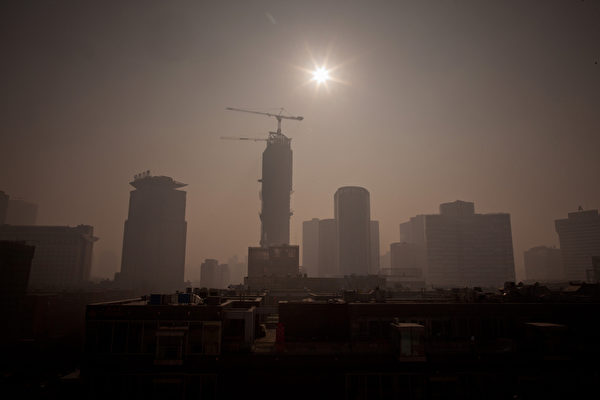China’s former billion-dollar real estate giant, “Huaxia Happiness,” recently faced bankruptcy reorganization due to owing 4.17 million yuan in construction payments, triggering concerns as the issue stemmed from operational funds rather than financial debts. The crisis in the current Chinese real estate market has been spreading, with struggling real estate companies slow to progress in debt restructurings, leading to an increase in secondary debt defaults.
On November 16, the once billion-dollar real estate giant, known as the “leader in the Beijing area,” Huaxia Happiness, announced that it had received a “Notice” from the creditor Long Cheng Construction, as well as a “Notice” from the Langfang Intermediate People’s Court in Hebei Province.
The documents revealed that Huaxia Happiness owed Long Cheng Construction a remaining balance of 4.17 million yuan in construction payments. Long Cheng Construction cited Huaxia Happiness’s failure to repay its debts on time and a clear lack of solvency as reasons for applying for the company’s reorganization through the Langfang court, along with initiating a pre-reorganization procedure. Currently, the Langfang court has accepted the “pre-reorganization” process.
Huaxia Happiness was one of the first troubled real estate companies and had already introduced a debt restructuring plan. As of October 2025, Huaxia Happiness had accumulated approximately 192.669 billion yuan through reorganization agreements. However, there is still over 24.569 billion yuan in debt that has not been fulfilled on time. Coupled with the fact that creditors have applied for pre-reorganization, it indicates that the original plan did not truly eliminate risks.
Bankruptcy reorganization and restructuring are both means for companies to adjust and improve during financial difficulties, but they have different focuses and legal natures.
Reorganization involves optimizing resource allocation and capital appreciation by adjusting a company’s assets, liabilities, and ownership. It is a voluntary strategic action by a company and typically does not involve legal proceedings.
Restructuring, on the other hand, occurs when a company faces financial crisis or is close to bankruptcy. Through legal means, the court adjusts the debts, capital, and operational management to restore the company’s profitability.
Huaxia Happiness is not the only troubled real estate company facing secondary defaults. For instance, Evergrande, which was the first to complete the extension of both domestic and foreign bonds at the end of 2022, fell into crisis again in 2024. Similarly, Modern Land’s offshore debt restructuring plan was approved in 2022, but it now faces a second default.
Despite the existing debt restructuring plan for Huaxia Happiness, why is the company still undergoing bankruptcy reorganization?
According to Song Hongwei, Co-Director of the Think Tank Institute, Huaxia Happiness was one of the first real estate companies to push for debt restructuring, and some conditions discussed at that time were much more favorable compared to this year. However, market conditions have changed significantly in recent years, rendering some conditions unattainable, leading to a second default.
Ba Wenxi, Vice Chairman of China Enterprise Capital Alliance, stated that Huaxia Happiness’s previous restructuring plan mainly addressed “large financial debts,” providing no unified legal protection for small operational debts (such as construction payments and material fees), resulting in a situation where the company is “restructuring on one side and being sued on the other.” With the company’s external credit still not substantially restored, small and medium creditors can only seek priority repayment through legal proceedings.
However, the fundamental issue with Huaxia Happiness lies in the comprehensive decline of its “profit-making function.”
In terms of operating performance, Huaxia Happiness reported a net loss of -6.028 billion yuan in 2023, -4.817 billion yuan in 2024. The company’s losses further expanded to 9.829 billion yuan in the first three quarters of 2025.
As of the end of the third quarter of this year, the company’s total assets were 274.518 billion yuan, a 9.8% decrease from the previous year; the net assets attributable to shareholders were -4.738 billion yuan, down 215.7% from the previous year.
The ongoing real estate crisis in China has been escalating. According to data from the China Index Research Institute, since 2020, 77 real estate companies in China have defaulted on their debts by August 2025, with about 60 troubled companies having announced debt restructuring plans. Only 20 of these plans have been approved so far.
Industry experts widely believe that both leading real estate companies and small to medium developers are facing debt crises, with cases of broken fund chains and halted projects becoming increasingly common. On the demand side, the pressure on residents to supply housing is continuously rising, leading to a rapid increase in default cases. Debt risks are spreading on both the supply and demand sides, and are gradually transferring to the banking sector, where the direct result is banks dealing with foreclosed properties.
The current real estate crisis, symbolized by Evergrande’s bond default, has been ongoing for four years, highlighting that this is not a normal price correction cycle but a long-term downturn triggered by debt crises. Lou Jiwei, former Minister of Finance of the Communist Party of China, stated on November 14 at the 16th Caixin Summit that the real estate market slump could last another five years.
With China’s real estate market downturn far exceeding expectations, traditional methods of relying on debt extensions and asset sales are no longer sufficient to help companies out of the quagmire.

